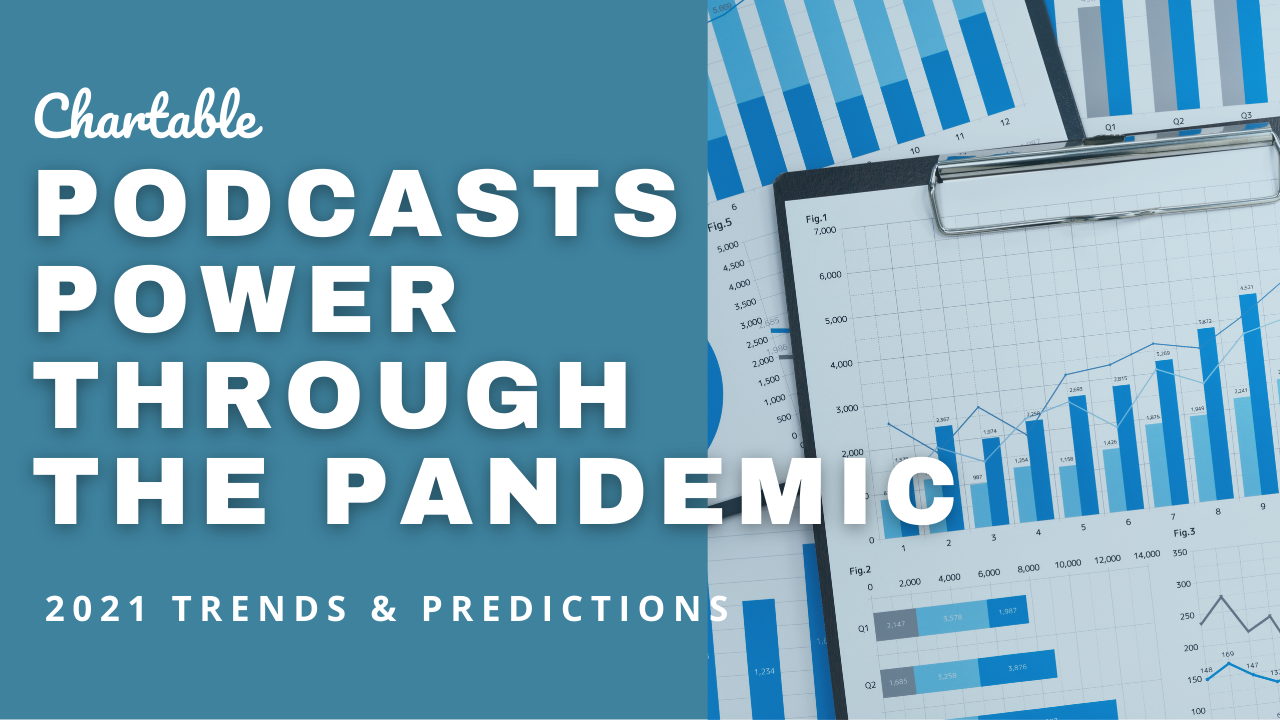Despite the headwinds the broader media and advertising industry faced in 2020 and the chaos brought on by the pandemic, the podcast industry thrived throughout the year. By every metric, podcasting performed well: ad revenues were up 15%; 17,000 new podcasts were started each week; 160 advertisers bought ads for the first time each week; and Chartable measured over 180% more monthly downloads.
In this post, I'll examine:
- How podcasts thrived through the pandemic
- The explosive growth trends in content and listening, both in the US and globally
- What's in store for 2021 as the corporate consolidation of podcasting continues
The coronavirus pandemic upended the world in the first quarter of 2020. In the US, podcast downloads and listening took an immediate hit as routines (and especially commutes) were disrupted.
However, all that listening returned quickly as people developed new routines for the lockdown/shelter-in-place era. As Digiday reported in July, "Over the past two months, podcast downloads have returned to their pre-COVID levels... And advertisers, more focused than ever on justifiable investments, have kept spending up, agency and publisher sources said."
The Internet Advertising Bureau report on podcast advertising stated that despite the pandemic, podcast ad revenues were expected to climb 15% in 2020, and advertisers reported that they planned to increase spend through the 2nd half of the year. By contrast, podcast advertising grew 49% in 2019 according to the previous IAB report.
Despite the revised growth outlook, the pandemic offered an opportunity for new brands and advertisers to try podcasting for the first time; according to data from Magellan, over 160 new brands entered the podcast market for the first time every week in 2020, and the trend accelerated throughout the year. And those advertisers were placing ads on more shows—On average, the number of shows an advertiser appeared on increased from 3.6 in January to 6.2 in november.
The growth in audio consumption wasn't limited to podcasting. Audiobooks also saw growth last year, with a 21% year-over-year increase from 2019. And according to TechCrunch, music streaming revenues grew 12% in the first half of 2020 as well: "With vastly more people stuck inside seeking novel methods of entertainment, paid subscriptions (Spotify, Apple Music, et al.) are up 24% year-over-year."
At Chartable, we've seen incredible growth in every metric we track from both publishers and advertisers—and we expect 2021 to be an even better year as the world returns to normalcy.
2020 saw a more than 280% increase in the creation of new podcasts -- from just over 300,000 new podcasts started in 2019 to almost 900,000 in 2020. That's almost 2 podcasts started every minute, throughout the entire year! [1]
Many of these new podcasts have just one or two episodes (about 30%) -- they reflect creators "trying out" the medium through free tools like Spotify's Anchor. However, 23% of podcasts started in 2021 have already published more than 10 episodes. That adds up to more than 200,000 new podcasts with real staying power. There's no denying that the sheer volume of new podcasts reflects an ever-increasing interest in the medium from creators.
Another very important trend: new creators aren't just limited to the US. Just under half of the 900,000 new podcasts were in languages other than English.
There were twice as many new English-language podcasts started in 2020 compared to the previous year. But many languages saw much more growth, including Hindi (14x), Chinese, Portuguese, Indonesian and Spanish (about 7x each), and others like Japanese, Turkish and Italian (about 3x each).
All of these new creators are creating all kinds of new content. The top category for new podcasts created last year was Education, followed by Society & Culture, Arts, and Business:
The global explosion in podcast creation has been met by a similar growth in audience.
At Chartable, we're now directly measuring 1.2 billion downloads a month from over 13,000 podcasts, from the tiniest independents to the largest publishers in the world. Because we're based in the US, our data is biased towards US listeners—but we've seen incredible global growth in downloads this year.
Chartable-measured US traffic grew 190% in 2020; many other countries saw much greater increases [2], including Turkey, Italy, Peru, and others. You'll notice a lot of overlap with the top languages for new creation here:
This explosive growth in audience and podcast creation has been playing out over a backdrop of increasing corporate competition and consolidation in the industry.
Many new creators are using Spotify-owned Anchor to create their podcasts, and many new listeners are using Spotify as their primary podcast player.
As we've noted in the past, Spotify's share of unique devices downloading podcasts continues to grow:
Global trends in content and listenership shed light on Spotify's grand podcasting strategy: they've now purchased some of the most critically-acclaimed and/or popular content in the industry (Gimlet, The Ringer, Joe Rogan); purchased tools for creating and monetizing podcasts both at the hobbyist end of the spectrum (Anchor) and for large enterprise publishers (Megaphone); and continue to bring new listeners to the medium through the Spotify app itself.
And because many non-US markets are dominated by Android devices which otherwise have lacked a good, visible default podcast player like Apple Podcasts provides for iPhone, Spotify continues to bring new listeners to the medium. It's a powerful combination of content, technology, and distribution.
Spotify isn't the only company with big podcast ambitions. The podcast acquisition market began to heat up in 2019, but 2020 was an even bigger year. Other companies have noticed Spotify's ambitions and aggressive execution and have begun making acquisitions of their own.
Here are just a few of the acquisitions in recent years — note the number of deals in 2020 significantly increased:
SiriusXM acquired the music streaming service Pandora and adtech provider Adswizz in 2018, and the company continues to expand its efforts in the podcast market, acquiring hosting service Simplecast and podcast app and ad network Stitcher/Midroll last year.
Amazon notably entered the podcast market with both Amazon Music and Audible offering podcasts this year. They've entered the acquisition market as well, buying Wondery, the top independent podcast network, in a deal that closed in late December of last year. In case it wasn't clear prior to the acquisition, Amazon has been moving aggressively to pursue an audio strategy, purchasing Wondery, the top independent podcast network in the US.
The ongoing consolidation of the podcast market can be seen in the ownership of podcast hosting platforms. We examined a dataset of approximately 1,800 podcasts which reached the Apple Podcasts Top 250 chart in the US during the entire year of 2020. Here's how their hosting providers break down by company:
But given the acquisitions that happened this year, we can group hosting providers together by their corporate ownership, which offers a different picture:
Similarly, looking just at shows that have reached the top 20 in Apple Podcasts during 2020, ownership is beginning to consolidate as well. With a single acquisition, Amazon now owns more podcasts that reached the Apple Top 20 last year than any other company. (Given that they control distribution on their own platform, Spotify's podcasts may be more popular on Spotify, of course):
Expect this consolidation to accelerate as Apple, Google, Spotify, Amazon, SiriusXM, and Entercom/Radio.com all assess their audio strategies and make additional acquisitions.
As the industry consolidates, one of the most important dynamics that we'll see playing out over the coming year is the interplay between exclusive content and expanded targeting/measurement available on platforms like Spotify and Pandora. Measurement, targeting, and attribution have been long standing challenges in the podcasting industry because traditional podcast ads can only be placed at the time the podcast episode is downloaded, and it's difficult to confirm that a specific listener actually heard a full ad. That's why we've built Chartable's full-stack podcast analytics and attribution suite.
With Spotify and Pandora's investments in adtech, advertisers are likely to receive more information for ads served exclusively on those platforms. This means there will be different advertising and monetization opportunities in the "closed" ecosystem of apps vs. the "open", RSS-based ecosystem.
As companies like Amazon, Spotify, SiriusXM, iHeartMedia and others continue their investment and acquisitions in podcasting, the ecosystem will certainly change. Will we end up with an ecosystem more like on-demand TV, where every media company has its own app and listeners (and advertisers!) need to juggle different platforms? Will Amazon or other tech companies continue to invest in podcasting to catch up (or surpass) Spotify? How will independent producers and networks thrive in this era of corporate consolidation? We'll have to wait and see.
Regardless of what happens on the corporate front of podcasting, the fundamentals of audio are strong. Around the world, more and more listeners are tuning in to podcasts. More and more creators are starting podcasts for the first time. And more and more advertisers are exploring the medium and increasing their spend, which means there's more money that will flow to creators to fund even more great shows.
I wasn't the only one who called 2019 the beginning of the Golden Age of Podcasts, and despite the naïvete the title of post implies, I couldn't be more optimistic about the future of this medium. As we (hopefully) put the COVID pandemic to rest around the world, the explosive growth trends for listeners, advertisers, and great content will not just continue, but accelerate. 2021 is going to be a great year for audio.
If you liked this post, please consider sharing it on: Facebook · Twitter · LinkedIn · Via email
Chartable builds world-class podcast measurement tools for publishers, agencies, and brands. We're trusted by iHeartMedia, Wondery, Vox Media, and thousands of other publishers to handle more than 1.2 billion downloads per month. Chartable's marketing suite helps both indie creators and major media publishers grow their podcasts—Chartable SmartLinks are the only solution in the podcast market to track the effectiveness of marketing and ad campaigns. Agencies and brands rely on Chartable's innovative SmartAds podcast advertising attribution to properly assess the effectiveness of their ad spend. The company is backed by top investors including Initialized Capital, Greycroft, and Naval Ravikant. To learn more, visit chartable.com.
[1] As we noted in our previous roundups of podcast statistics, all data in this post is based on Chartable's database of global podcasts, episodes, and charts. There are likely many more podcasts created in 2020 that haven't made themselves known to our web crawlers; similarly, because we started Chartable in 2018, there are likely many podcasts created before we started the company that we may have missed. Still, our data set is robust, with around 2M podcasts in total, and nearly 100 million episodes indexed.
[2] In the interest of completeness, I'll note that we saw a 3500% increase in unique devices downloading from Taiwan because a Taiwanese podcast hosting company (soundon.fm) decided to allow their users to integrate with Chartable more easily (thanks folks!). This is so far out of line with the rest of the countries, I had to remove it from the list. One potential takeaway: podcast hosting still seems to be a geographically local market, and there might be large pockets of creators & listeners that are less visible to companies like Chartable because they use country or language-specific platforms.




